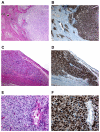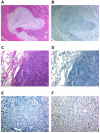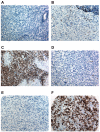Cyclin D1 as a diagnostic immunomarker for endometrial stromal sarcoma with YWHAE-FAM22 rearrangement
- PMID: 22982899
- PMCID: PMC3444748
- DOI: 10.1097/PAS.0b013e31825fa931
Cyclin D1 as a diagnostic immunomarker for endometrial stromal sarcoma with YWHAE-FAM22 rearrangement
Abstract
Endometrial stromal sarcoma (ESS) characterized by YWHAE-FAM22 genetic fusion is histologically higher grade and clinically more aggressive than ESS with JAZF1-SUZ12 or equivalent genetic rearrangements, hence it is clinically important to recognize this subset of ESS. To identify diagnostic immunomarkers for this biologically defined ESS subset, we compared gene expression profiles between YWHAE-FAM22 ESS and JAZF1-rearranged ESS. These studies showed consistent upregulation of cyclin D1 in YWHAE-FAM22 ESS compared with JAZF1-SUZ12 ESS. Immunohistochemically, the high-grade round cell component of all 12 YWHAE-FAM22 ESS demonstrated diffuse (≥70%) moderate to strong nuclear cyclin D1 staining, and this diffuse positivity was not seen in 34 ESSs with JAZF1 and equivalent genetic rearrangements or in 21 low-grade ESS with no demonstrable genetic rearrangements. In a series of 243 non-ESS pure uterine mesenchymal and mixed epithelial-mesenchymal tumors, only 2 of 8 undifferentiated endometrial sarcomas with nuclear uniformity and 1 of 80 uterine leiomyosarcomas demonstrate diffuse cyclin D1 immunoreactivity. Both cyclin D1-positive undifferentiated endometrial sarcomas showed diffuse strong CD10 staining, which is consistently absent in the high-grade round cell component of YWHAE-FAM22 ESS. The low-grade spindle cell component of YWHAE-FAM22 ESS showed a spatially heterogenous cyclin D1 staining pattern that was weaker and less diffuse overall. Our findings indicate that cyclin D1 is a sensitive and specific diagnostic immunomarker for YWHAE-FAM22 ESS. When evaluating high-grade uterine sarcomas, cyclin D1 can be included in the immunohistochemical panel as an indicator of YWHAE-FAM22 ESS.
Figures






Comment in
-
Cyclin D1 does not distinguish YWHAE-NUTM2 high-grade endometrial stromal sarcoma from undifferentiated endometrial carcinoma.Am J Surg Pathol. 2015 May;39(5):722-4. doi: 10.1097/PAS.0000000000000427. Am J Surg Pathol. 2015. PMID: 25871469 No abstract available.
Similar articles
-
[Endometrial stromal sarcoma: morphologic features and detection of JAZF1-SUZ12 and YWHAE FAM22 fusion genes].Zhonghua Bing Li Xue Za Zhi. 2016 May 8;45(5):308-13. doi: 10.3760/cma.j.issn.0529-5807.2016.05.005. Zhonghua Bing Li Xue Za Zhi. 2016. PMID: 27142911 Chinese.
-
The clinicopathologic features of YWHAE-FAM22 endometrial stromal sarcomas: a histologically high-grade and clinically aggressive tumor.Am J Surg Pathol. 2012 May;36(5):641-53. doi: 10.1097/PAS.0b013e31824a7b1a. Am J Surg Pathol. 2012. PMID: 22456610
-
Aggressive behavior and poor prognosis of endometrial stromal sarcomas with YWHAE-FAM22 rearrangement indicate the clinical importance to recognize this subset.Int J Gynecol Cancer. 2014 Nov;24(9):1616-22. doi: 10.1097/IGC.0000000000000278. Int J Gynecol Cancer. 2014. PMID: 25244606
-
JAZF1/SUZ12 gene fusion in endometrial stromal sarcomas.Orphanet J Rare Dis. 2016 Feb 16;11:15. doi: 10.1186/s13023-016-0400-8. Orphanet J Rare Dis. 2016. PMID: 26879382 Free PMC article. Review.
-
Endometrial stromal tumors: the new WHO classification.Adv Anat Pathol. 2014 Nov;21(6):383-93. doi: 10.1097/PAP.0000000000000046. Adv Anat Pathol. 2014. PMID: 25299308 Review.
Cited by
-
Clinically Relevant Molecular Subtypes in Leiomyosarcoma.Clin Cancer Res. 2015 Aug 1;21(15):3501-11. doi: 10.1158/1078-0432.CCR-14-3141. Epub 2015 Apr 20. Clin Cancer Res. 2015. PMID: 25896974 Free PMC article.
-
Management of uterine sarcomas and prognostic indicators: real world data from a single-institution.BMC Cancer. 2018 Dec 13;18(1):1247. doi: 10.1186/s12885-018-5156-1. BMC Cancer. 2018. PMID: 30541504 Free PMC article.
-
[Mesenchymal and mixed uterine tumors : Current overview and practical aspects].Pathologe. 2019 Feb;40(1):36-45. doi: 10.1007/s00292-019-0567-6. Pathologe. 2019. PMID: 30694356 Review. German.
-
[New features in the 2014 WHO classification of uterine neoplasms].Pathologe. 2016 Nov;37(6):500-511. doi: 10.1007/s00292-016-0230-4. Pathologe. 2016. PMID: 27738815 Review. German.
-
Novel High-grade Endometrial Stromal Sarcoma: A Morphologic Mimicker of Myxoid Leiomyosarcoma.Am J Surg Pathol. 2017 Jan;41(1):12-24. doi: 10.1097/PAS.0000000000000721. Am J Surg Pathol. 2017. PMID: 27631520 Free PMC article.
References
-
- Abeler VM, Royne O, Thoresen S, et al. Uterine sarcomas in Norway. A histopathological and prognostic survey of a total population from 1970 to 2000 including 419 patients. Histopathology. 2009;54:355–364. - PubMed
-
- Amant F, Tousseyn T, Coenegrachts L, et al. Case report of a poorly differentiated uterine tumour with t(10;17) translocation and neuroectodermal phenotype. Anticancer Res. 2011;31:2367–2371. - PubMed
-
- Andino L, Cagle PT, Murer B, et al. Pleuropulmonary desmoid tumors: immunohistochemical comparison with solitary fibrous tumors and assessment of beta-catenin and cyclin D1 expression. Arch Pathol Lab Med. 2006;130:1503–1509. - PubMed
-
- Blattner JM, Gable P, Quigley MM, et al. Primitive neuroectodermal tumor of the uterus. Gynecol Oncol. 2007;106:419–422. - PubMed
-
- Bosch F, Jares P, Campo E, et al. PRAD-1/cyclin D1 gene overexpression in chronic lymphoproliferative disorders: a highly specific marker of mantle cell lymphoma. Blood. 1994;84:2726–2732. - PubMed
Publication types
MeSH terms
Substances
Grants and funding
LinkOut - more resources
Full Text Sources
Research Materials

